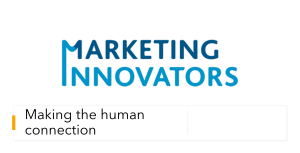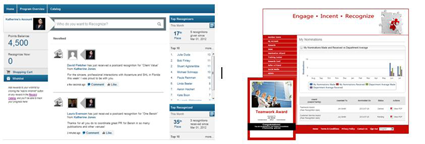Social Recognition: Is the Latest Application of Social Media the Most Powerful Yet?
Sponsored by Marketing Innovators
Quick Jump to Article Contents
Click here to download the PDF version
“The deepest human need is the need to be appreciated.”
- William James, 19th Century Author, Psychologist and Philosopher
Introduction
Praise, recognition and appreciation have long been recognized by philosophers and psychologists as critical to human happiness. Effective teachers, managers and parents also know that recognition and praise are among the most powerful motivational tools at their disposal. Consistent findings from research provide indisputable evidence of the near causal link between recognition, engagement, performance and profit. Indeed, almost a decade ago, Gallup analyzed data from interviews and surveys involving more than 10 million workers to conclude that variations in recognition and praise account for ten to twenty percent differences in productivity among employees and revenue, as well as in customer engagement. 1
The debate, if there ever was one, is not whether recognition, praise and appreciation are important to productivity, rather how can organizations accelerate the incidence of recognition and develop it into their culture ― their DNA ― so to speak? In the past, the process could take
years, and only then when executive management was deeply, consistently, and publicly committed to it. Today, the promise of social media and peer-to-peer recognition stands to turn this paradigm on its head. Social Recognition tools and technology are helping early adopters increase the frequency and meaningfulness of recognition, integrate recognition with corporate goals and, ultimately, to build enduring “cultures of recognition” quickly.
1 Rodd Wagner and James Harter, “12: The Elements of Great Managing”, Gallup, 2006
Why “Social Recognition”?
Today the word “social” is less likely to conjure thoughts of companionship and society than to have people thinking media, networking, blogging, tweeting and gaming. According to research from Bersin & Associates, “social is the dominant form of internet communication on the planet.”Tellingly, 39% of 18-24 year olds would consider leaving a job if they were not allowed to access sites like YouTube and Facebook from work.2
In the world of talent management, social networks have been used successfully in knowledge sharing, the identification of skills and construction of teams, in recruiting, onboarding and certainly learning. “Social Recognition” is a relative newcomer to the party, yet successful public social networks, such as Facebook and LinkedIn have featured recognition as a mainstay from the beginning. It is arguable that among the chief drivers of the popularity of social networks (Facebook has recently passed an astonishing one billion users) is the ability of people to recognize and be recognized. “Likes”, “Thumbs Up” and other icons, alone or combined with messages, proliferate. There can be little doubt that people use social networking sites, at least
in part, to fulfill a deep seated need for recognition.
Perhaps even more than in our private lives, we crave recognition at work. The unfortunate reality, though, is that most organizations do a poor job of recognition. For example, U.S. Department of Labor research has found that 64 percent of working Americans leave their jobs because they do not feel appreciated. In many organizations, recognition occurs only annually ― during the performance review. Indeed, recent research reveals that 56 percent of employees believe their peers are recognized just once per year or never – and that 70 percent of employees say they themselves are recognized only once per year or never.3
As Harvard psychologist and author William James said more than 150 years ago, “The deepest human need is the need to be appreciated.”In the workplace, however, recognition is not important for its own sake. Most leaders acknowledge that satisfying employees’ needs ─ at least their fundamental needs ─ is essential to driving engagement and performance. And so experts and consultants advise organizations to develop a “culture of recognition.” Many emphasize the need to better select and hire leaders, and/or to develop them so that they know how and when to recognize employees. Doubtless, recognition from the boss is important but a true culture of recognition, one in which appreciation is frequent and meaningful, cannot be a top-down exercise alone. Social Recognition, which uses software to enable people to recognize one another, is a relatively new entrant in the pantheon of talent management technology. Yet it draws on practices from some of the world’s most popular internet applications. In connecting peers to peers, and in this case, employees to employees and employees to customers, partners, suppliers and others (the extended enterprise) it opens another dimension in recognition that has the potential to generate powerful cultural evolution within remarkably short timeframes.
In others words, social recognition software can be transformative. It can fill a recognition gap quickly and it can extend recognition beyond the organization to help engage customers and other constituents.
2 New Talent Technologies: Managing People Better, Bersin & Associates, 2012
3 The State of Employee Recognition in 2012.Bersin & Associates.P11
Social Recognition on the Web
In the broadest sense, social recognition has been part of the community fabric ever since man gathered into collaborative groups; to evolve and advance in ways that would not have been possible on an individual basis. Public displays, ceremonies, the sharing of stories, recognition events, acknowledgements of a person's status and/or merits (achievements, virtues, service, contribution etc.) were, and still are, common occurrences―performed in social settings. Hence, recognition by its nature in the physical world is inherently social.
However, the notion of social recognition from today’s connected-business perspective has evolved, and will continue to evolve, into something quite different―as the lines between the physical and virtual worlds are constantly blurred by advances in social networking concepts, practices, applications and technologies. Utilizing online networking technology models for communities of people to recognize and reward the contributions of others is a natural extension of existing on-demand recognition and reward systems in use today.
More organizations are realizing that a connected workplace is not just about implementing new enabling technologies; it is also about adopting organizational design changes that focus on an open workplace environment where employees are encouraged to share, recognize, collaborate and innovate virtually. Online social recognition provides the foundation for this transformation and can be instrumental in spurring vital value-creating shifts in an organization’s direction.
Certainly, the on-line world is rife with peer-to-peer recognition. Most social media, including blogs, discussion boards, magazines and news outlets
invite ratings, “likes” and other feedback from users. The most popular social networking sites encourage recognition also (Figures One and Two). A typical Facebook or LinkedIn page provides numerous examples. Popular social media sites have also morphed to become social referral and recruiting tools used to make introductions, recruit members, and even for match-making. They have also become tools for recruiters, both to promote
positions and connect with prospective employees. Many recruiters also use the sites to “investigate” and screen applicants based on the ppropriateness of some of their social media activity.
Figure One: Social Recognition on LinkedIn
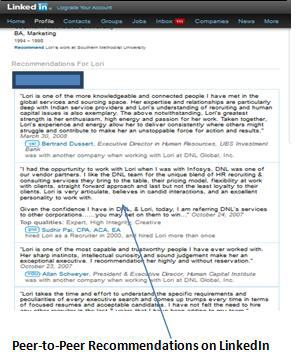
Figure Two: Social Recognition on Facebook
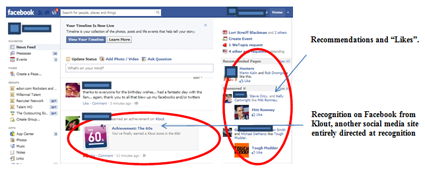
As Facebook passes the billion subscriber mark, social media is already the number one activity of the web (Socialnomics.net, 2011). According to Nielsen in 2009, “In the U.S. alone, total minutes spent on social networking sites increased 83 percent year-over-year. Incredibly, total daily minutes spent on Facebook have increased from 1.7 billion minutes in April 2008 to 10.5 billion in January 2012 – and that figure does not include access on mobile devices.4
The use of social networking technology has grown incredibly inside organizations as well. By many estimates, the adoption rates of corporate social network applications has surpassed even that of email inside organizations (see figure three). To many a college student or “millennial” email is already akin to cursive writing – an anachronism. Clearly then, it is difficult to argue against social media and social networking as a “fad” or an insignificant development as far as business is concerned. Increasingly, corporate social platforms are becoming the medium of choice.
Figure Three: The Growth of Corporate Social Networks
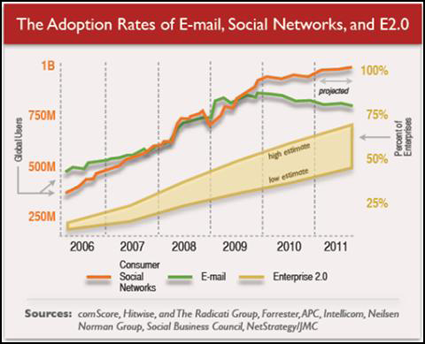
4 “10.5 billion minutes spend on Facebook daily, excluding mobile”, Emil Protalinkski, ZDNet, March 28, 2012
Social Recognition in Organizations
Inside organizations, social media is used in an intranet environment to disseminate information, encourage knowledge-sharing and to connect the workforce for collaborative purposes. Given the fundamental “recognition” elements of popular public social networks, it is somewhat surprising that recognition is late to the game inside organizations. Nevertheless, the gap has closed quickly, there are numerous technology providers now offering services that enable online social recognition.
“The global village has been shrunk down to the size of a smartphone.”
The fundamental advantage online social recognition brings to organizations – even those with formal recognition programs – is that appreciation and recognition becomes an ongoing, daily activity, driven predominantly by employees recognizing other employees (as opposed to an annual, formal evaluation driven by management). In this way, organizations stand a much better chance of building a culture of recognition and will do so relatively quickly.
Beyond employee to employee recognition, corporate social recognition can also connect employees to customers, partners, suppliers and other key constituents to give and receive recognition. Where employees can reach out to recognize colleagues’ contributions and those of the broader, external community (those critical to the success of the organization); resulting in widespread enterprise-wide engagement and increases in productivity.
Experts clearly agree on one thing: the world of social recognition is not a trend that will fade away. It is really the next-generation evolution of reward and recognition systems many organizations already have in place. And in the future social recognition platforms will prove to be the first view or window into the currency of knowledge and creative expertise that resides within the organization―supported by the powerful collaborative systems and social-strategy tools of tomorrow. When one thinks about successful companies it all comes down to people and the quality of their conversations and interactions. Hence, social recognition is not a fad or trend relative to programs, tools and platforms. It's about a new collective way of working, talking and learning—a cultural transformation grounded in social learning.
The Network is the Competitive Advantage
For many people celebrating successes, sharing stories, perspectives, views and insights online is a daily event, yet until recently this bears little resemblance to the way we work. Traditionally, businesses operated in silos, impairing collaboration and co-action between
colleagues and cross-functional practitioners. As a result, corporate knowledge, people, processes and vital information remained hidden.
In order to succeed, organizations must adapt or die. In today’s business environment competition is no longer a contest between companies; it’s really a competition between networks―the sum of connectivity, communications, collaboration and reward and recognition systems used to empower a collective value-chain. Giving employees the ability to dynamically celebrate, converse, innovate, and engage in an agile manner will only help businesses grow and remain competitive.
Today, people are more social than ever before. The global village has been shrunk down to the size of a smartphone. The online tools that make it easy to connect and work together are starting to disrupt traditional views about workforce practices in ways that organizations are only just beginning to realize. A whole new notion of social learning is beginning to evolve around the distillation and distribution of knowledge and recognition of its individual
contributors. There is a growing understanding that rather than being a distraction or a time drain, social connectivity could actually hold the key to a more productive way of doing business; by providing an engaging virtual-forum for showcasing achievements, recognizing people, leveraging social currency and identifying pockets of expertise within the organization.
The Recognition Gap
Peer-to-peer recognition can be a powerful force in driving a sustainable high-performance culture, yet the majority of organizations – even those with formal recognition programs – do not incorporate the notion of employees recognizing other employees. According to Bersin & Associate’s “State of Employee Recognition 2012” research, the top reason employees do not recognize each other is simply because there is no established way to provide recognition in most firms (Figure Four). In other words, there is no barrier to peer-to-peer recognition from a willingness or attitudinal perspective. Employees want to recognize each other, they just need the tools to do so.
Figure 4: Top Reasons Employees Do Not Recognize Each Other
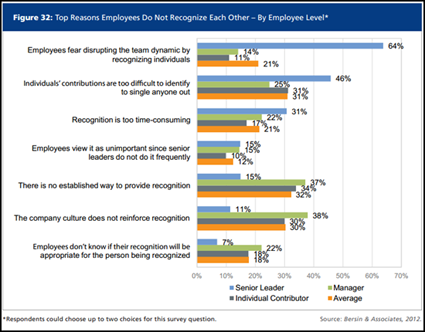
Organizations can overcome this barrier by implementing simple tools that allow employees to recognize colleagues’ work and contributions. Corporate Social Network (CSN) platforms, Social Recognition technologies or add-ons to intranets and CSN are relatively simple tools that enable recognition through short statements, the awarding of points and/or by telling stories about what colleague(s) did that merits recognition (Figure Five). Over time, these statements, awards and stories grow to become part of the legacy of a recognition culture.
Figure Five: Examples of Social Recognition Technology
Social Recognition software can increase the frequency of appreciation and also provide guidelines to employees on when recognition is appropriate. The tools can allow for varying levels of sharing, so that some recognition can remain private, others limited to a team and some shared enterprise-wide ― even out to (and in from) customers, partners and other constituents of the extended enterprise. Combined with a cascading or SMART goals program, the software may be equipped to align recognition with performance management. Most software will also include useful analytics and reporting tools to help gauge progress and make adjustments. As traditional job roles are increasingly being reframed around enabling a more modern, collaborative work culture that reflects the way people function today in their interconnected, networked world, next-generation solution(s) need to support a combination of social recognition, media and collaborative tools that allow professionals to:
- Recognize contributions
- Inspire performance and drive value-adding activities
- Reinforce behaviors and organizational culture
- Showcase achievements and provide public validation
- Foster collaboration, conversation and recognition
- Find people, information or expertise more quickly
- Foster knowledge sharing and Social Learning
- Widen personal networks, build relationships, and raise visibility of individual profile
- Identify subject matter experts (SMEs)
- Build meaningful relationships (across a distributed workforce)
- Support Communities of Practice (groups of people with domain expertise)
- Extend corporate knowledge
- Invite peers into a personalized group
In essence, a Social Recognition solution should function as an enabler and driver of existing
core capabilities, values, attributes and strategic plans.
Extending Social Recognition
As soon as one acknowledges the increasingly important role of social media and social networking in corporate communications, the path forward is clear. Organizations should support and foster the growth of internal social networking to encourage collaboration, ideasharing, innovation and knowledge transfer. Equally, the tools should include components– like Social Recognition –that are likely to accelerate team-building, employee engagement and productivity.
Given the state of volatility, uncertainty, complexity, ambiguity, and information overload in today’s business environment, organizations must learn to leverage highly-collaborative networks and nodes to competitively sense and respond to the marketplace and remain competitive. Corporate transparency, collaboration, and knowledge-sharing will become the harbingers of success. A key element of any social platform is the ability for individuals to provide feedback, insights and positive reinforcement. Social recognition will be an integral part of these systems designed to bolster connectivity and the flow of information and creative conversation. Employees who can share and access information with their colleagues – the
contextual knowledge which is so valuable to awareness –is increasingly vital to succeed in today’s competitive global business landscape.
Yet beyond today’s social recognition tools that focus on employees, are additional competitive advantages for organizations that extend recognition to other critical stakeholders. Customers, partners (including resellers), suppliers and even volunteers where applicable, are crucial to organizations’ success and should not be overlooked. A social recognition strategy should include a means for recognition to and from the extended enterprise to be captured and shared. In the same way that employee recognition drives employee engagement, recognition (to and from) stakeholders will drive Enterprise Engagement. Foundational transformation around the culture and people of the organization, including its customers, partners and suppliers, are essential to an its enduring success. As the pace of business change accelerates and the world becomes more interconnected, the quality of agility and responsiveness of the extended-enterprise will be its most critical competitive advantage. Social networks and their recognition components are key pieces in the integrity of the connected extended enterprise.
Conclusions
By internet standards, social media took its time getting to recognition in the workplace. Yet a better application of corporate social networking would be difficult to find. The age-old problems of finding and/or developing managers and supervisors talented and aware enough to build and sustain a culture of recognition is, in part, solved through peer-to-peer and extended enterprise social recognition. Moreover, the disadvantage of recognition taking place
(if at all) during annual, formal performance reviews can be replaced with ongoing feedback and recognition from peers, managers, subordinates and even to and from the extended enterprise.
That a culture of recognition is a prime advantage in driving employee engagement is taken for granted by most leaders today and is nothing new. The hurdle has always been achieving that culture within a broader workforce culture that has long emphasized bottom line results, short term goals and rewards for individual achievement. Managers and supervisors are constantly told about the importance of recognition and engagement but rarely held accountable or rewarded for it directly. Yet the lessons from successful public social networks are there for all to see – they have succeeded, in part, based on people’s willingness and enthusiasm for recognizing each other.
Inside organizations, the same lessons apply. Today, the power of recognition is opening up, in fact, being driven by employees. However, as the research indicates, the main obstacle to social recognition is the lack of an official means for employees to recognize each other in the great majority of organizations. Social Recognition software and tools offer a simple, affordable solution.
Organizations are in a constant state of organic flux and must constantly adapt to accommodate performance objectives. Social recognition and its evolution will bring a new layer of sophistication to employee and extended enterprise interactions which will transcend the one dimensional approach of many existing reward and recognition programs.


